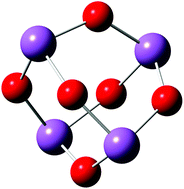The re-determination of the molecular structure of antimony(iii) oxide using very-high-temperature gas electron diffraction (VHT–GED)†‡
Abstract
The molecular structure of a fundamental binary compound [antimony(III) oxide] has been re-determined to a far higher accuracy and precision than previously reported. The structure is compared to those determined by various ab initio methods,

- This article is part of the themed collection: In Celebration of David Cole-Hamilton's Career in Chemistry

 Please wait while we load your content...
Please wait while we load your content...